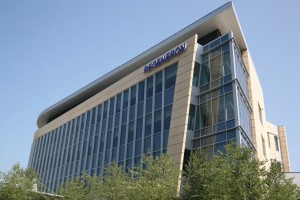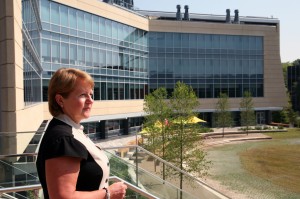Words from Albert Einstein greet visitors and employees entering the lobby of a new building recently opened for Regeneron Pharmaceuticals Inc. on the Landmark at Eastview life sciences campus in Mount Pleasant: “Logic will get you from A to B. Imagination will take you everywhere.”
For Regeneron”™s founding scientists and physicians, it would have required an impressive leap of imagination to foresee the extent of the biotechnology company”™s growth in office and laboratory space and employees when it arrived as a tenant on the Landmark campus in 1989.
The company, then only 1 year old and still nearly two decades away from marketing its first biopharmaceutical product, initially leased some 12,000 to 14,000 square feet of space in the Spine Building, the central building that connects the Greenburgh and Mount Pleasant sides of the 140-acre former Union Carbide campus.
On a visit there shortly after Labor Day, the Spine Building was a taped-off indoor avenue and obstacle course of construction to accommodate a portion of Regeneron”™s rapidly accelerated expansion in recent years. Brokers for Biomed Realty Trust Inc., the Landmark”™s San Diego-based owner, in August announced that Regeneron ”” now the state”™s largest biotech company and a global marketer with $999 million in total revenue in this year”™s second quarter ”” had leased an additional 116,200 square feet in the Spine and another campus building.
That lease expansion does not include the two 4-story buildings, totaling 297,000 square feet of office and lab space, which Biomed Realty has erected in a build-to-suit project for its anchor tenant directly across Old Saw Mill River Road from the Spine Building. The landlord”™s architect for the approximately $150 million project was Perkins & Will, the international architecture and design firm with a Manhattan office that also designed the buildings”™ natural-light-filled interiors for its client Regeneron.
With the new facilities, Regeneron will occupy more than 1.1 million square feet of space at the Landmark in seven buildings, said spokeswoman Erin Loosen. It has more than 2,200 employees at its Westchester headquarters and more than 1,100 employees at its upstate manufacturing facility in Rensselaer. The company”™s total full-time employees number nearly 4,000 globally, she said.
Those numbers do not include some 300 to 400 interns, temporary workers and contractors who also pass through Regeneron”™s Westchester facilities, said Joanne Deyo, Regeneron”™s vice president for facilities.
The two new buildings, one of which consists entirely of lab space, will be occupied by about 600 employees. Deyo, who joined the fledgling biotech company at the Landmark in 1991, said Regeneron is moving groups of workers into its new campus quarters every two weeks. The Regeneron Genetics Center, the company”™s wholly owned subsidiary launched about two years ago, has made the move.
“This (move) will allow us to rework the exiting space on the other side of the campus,” where Regeneron occupies four buildings, Loosen said.
“And allow us to have some breathing room” as employees continue to be hired, Deyo added.
The new buildings have been imaginatively designed and fitted with amenities such as a barista-run coffee and juice bar and small “huddle rooms” and corner nooks to encourage collaboration and informal meetings among employees.
“One of our major advantages here is our constant collaboration,” said Loosen.
“We try to design space that allows for that and allows people to ”˜chance-meet,”™” Deyo said.
The buildings were built to specifications that meet the silver certification standard of the U.S. Green Building Council”™s Leadership in Environmental and Energy Design (LEED) program. Loosen and Deyo said they expect the facilities could receive the higher LEED gold certification.
Its LEED-friendly features include a rooftop garden of native grasses and wildflowers atop The Nucleus, an elliptically shaped meeting room for company and public events; a 550-kilowatt solar-panel installation atop a 759-space parking garage with electric car charging stations; rainwater piped from roofs to new courtyard gardens; a security desk and office counters made of honey locust wood recycled from trees cleared to make way for the buildings; waste stream reduction measures, and thermal window shades and controlled lighting.
In the buildings”™ interior design, “We borrow the natural daylight,” Deyo said. “That”™s what it”™s all about.”
“We wanted to make sure we have highly sustainable buildings,” she said. “We have very carefully engineered all the building systems so they”™re highly efficient.
Regeneron executive have imagined a future where more genetics research discoveries and drug therapies developed in its collaborative spaces at the Landmark result in more marketed products globally ”” and a need for more physical expansion at home.
Regeneron last spring paid $73 million and became a commercial landowner in Westchester with its purchase of an undeveloped 100-acre parcel in Greenburgh on the Landmark at Eastview campus. Loosen at the time said the company closed the property deal “to offer flexibility for future growth.”




















